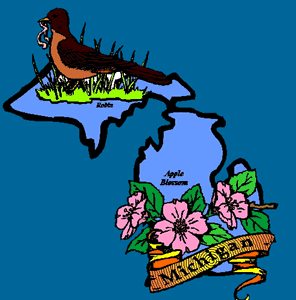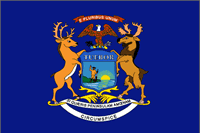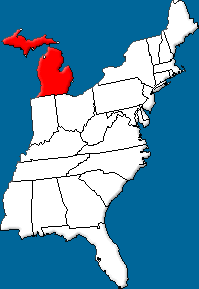 History:
The French explorer Etienne Brule was the first European to reach the Michigan region. Brule landed at the narrows of Sault St. Marie in 1620 and named the area New France. In 1634, Jean Nicolet was sent by France to explore sections of the Upper Peninsula, and find a route to the Pacific Ocean.
Gradually, other French explorers, traders, and missionaries came to the area. A mission was built at Keweenaw Bay in 1660. Eight years later, Michigan's first permanent settlement was established by Father John Marquette at Sault St. Marie. By 1700, most of the Michigan region had been explored by the French. Forts, missions, and trading posts had been built throughout the Upper and Lower Peninsulas. In 1701, Antoine de la Mothe Cadillac founded Fort Pontchartrain at the site of present-day Detroit.
The French did little to develop the region. They were primarily interested in converting the Native Americans to Christianity, establishing a profitable fur trade, and finding a northwest passage. Soon Britain and France began to struggle for control of North America. They fought in a series of conflicts known as the French and Indian Wars (1754-1763). The French were eventually defeated in 1763 and Britain won most of the French holdings in North America.
The Native Americans initially resented the coming of the British to the Michigan region. In 1763, under the leadership of Chief Pontiac, the Ottawa Indians attacked a number of forts and massacred many British settlers. The rebellion was short-lived, though, and the Native Americans eventually joined with the British against the Americans in the Revolutionary War (1775-1783). When the war ended in 1783, Michigan fell under control of the United States. But the British, unwilling to give up their valuable fur trade, stubbornly held on to Ft. Mackinac and Ft. Pontchartrain (Detroit) until 1796.
Michigan became part of the Northwest Territory in 1787 after passage of the Northwest Ordinance. In 1805, Congress created Michigan Territory, which included the Lower Peninsula and the eastern portion of the Upper Peninsula. Detroit became its capital.
During the War of 1812, the Native Americans once again sided with the British against America. Britain captured Ft. Mackinac and the city of Detroit. American forces regained Detroit in 1813, and the British returned Ft. Mackinac to the United States at the war's end in 1814.
The Erie Canal was completed in 1825, enabling settlers to easily reach western territories. Soon many Americans began moving to Michigan from eastern states. A state constitution was drawn up and the people of Michigan ratified the U.S. Constitution in 1835. But a land dispute with Ohio delayed Michigan's admission to the Union. Congress settled the dispute in 1836, giving Michigan the entire Upper Peninsula. Michigan entered the Union as the 26th state in 1837.
The lumber industry expanded rapidly in the years after statehood and the population grew as German, Irish, and Dutch immigrants began settling in the state. By 1845, mining began to thrive in the Upper Peninsula. However, the miners needed some way to transport the valuable minerals and ore to the iron and steel factories along the Great Lakes. This need led to the construction of the Soo Canal, which was completed in 1855.
Although no battles were fought on Michigan soil during the Civil War (1861-1865), the state sent 90,000 soldiers to fight for the Union. In 1865, the Fourth Michigan Cavalry under Lt. Colonel B. D. Pritchard captured Jefferson Davis, president of the Confederacy, near Irwinville, Georgia.
Between 1870 and 1900, the population of Michigan doubled. Settlers poured into the state, cleared land, and established farms. Saw mills were constructed and by 1870, Michigan became the nation's leading producer of lumber. |









